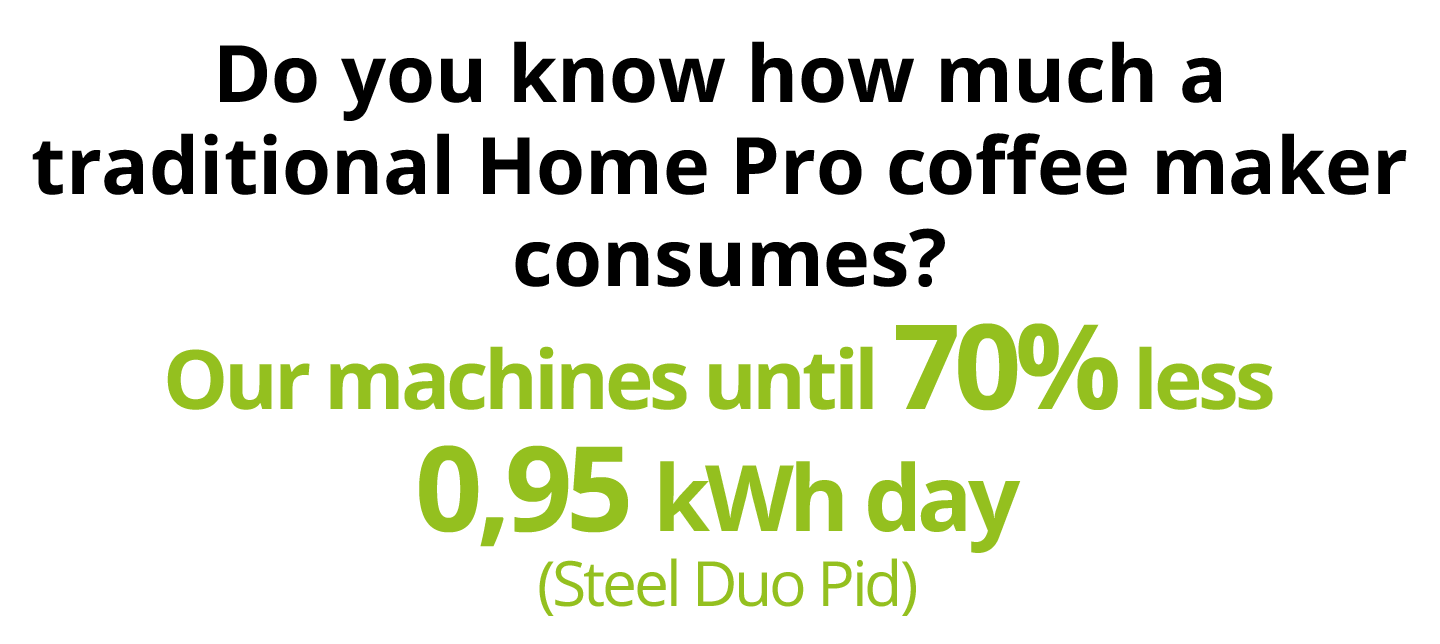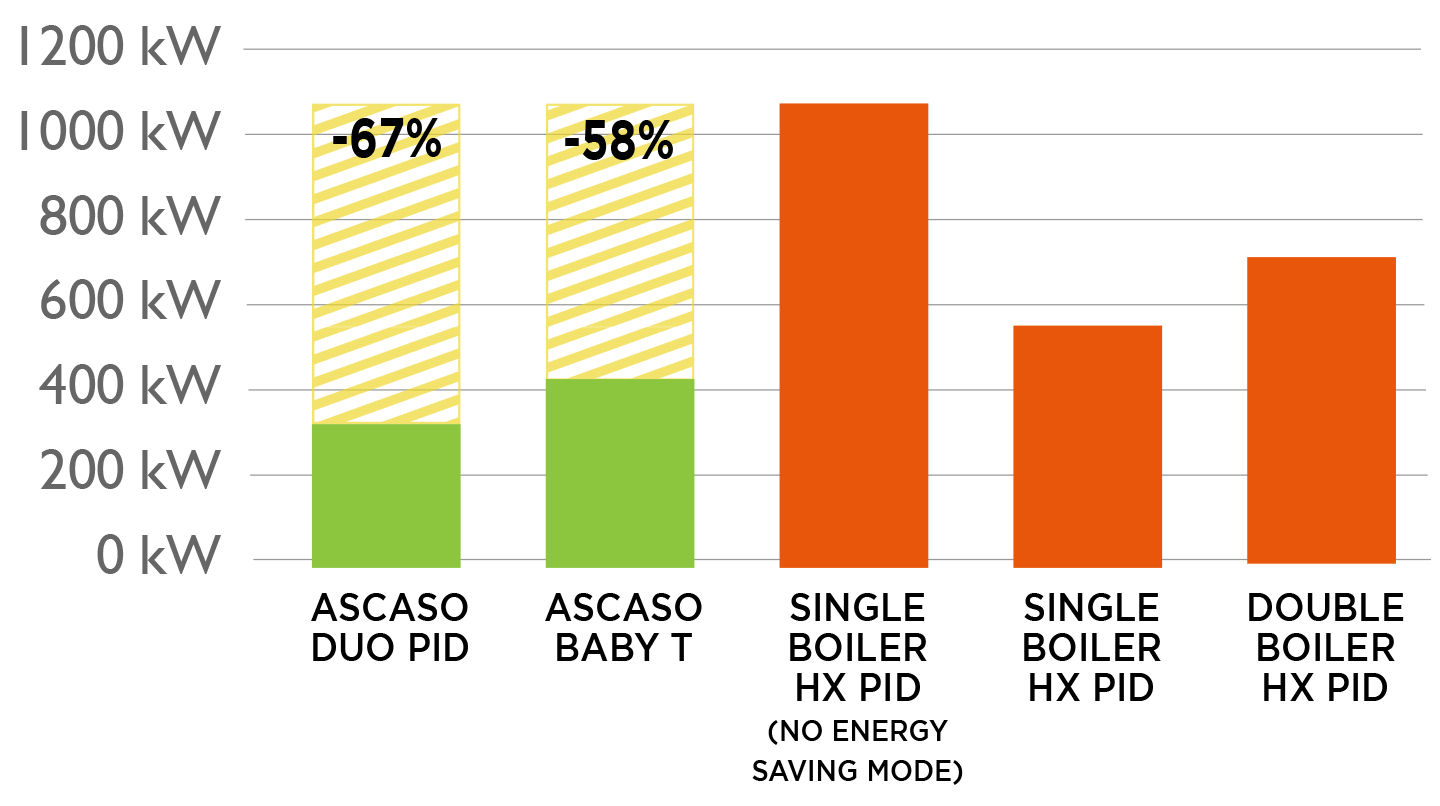Home Pro
Professional PID (vibratory pump)
Professional PID (rotary pump)
Close/Cerrar
Energy efficiency

We guarantee a saving 70% compared to a single boiler traditional coffee machine.
Energy consumption
Reducing the energy consumption of our coffee machines has been a priority goal for the last 10 years. The result of this process is the creation of our own technology, in a sector that primarily uses technologies from 60 years or 20 years ago, as in the case of the most popular and modern multi-boiler technologies.
We want to make public our result and, we hope, that many other manufacturers will follow this path. The result obtained, available to our clients, is based on the European protocol.

Energy savings = Economic savings
The energy consumption of a professional coffee machine is high. Also it is its hours of use. Consequently, financial savings are also important.
By doing a simple calculation, we can obtain an annual saving of more than € 175 on the electricity bill.
Average saving 1,96 kWh/24h. 365 days of annual opening. 0.25 kWh (average price in Europe).
Total: € 179 / year.
ANNUAL ENERGY CONSUMPTION

NOTE: Dream and Steel Uno models have a single group for coffee and steam, but they are even more efficient. They have a daily consumption of 0.56 kWd and 204.4 kWd per year.
Conclusions
DUO PID model is so far the most efficient model of the range. Not only because it is the one with a lower annual energy consumption (-67% compared with HX single boiler and -50% compared with HX double boiler), but also considering it is more powerful than any of the HX models (2.000 W vs 1.500/1.550 W).
So we have more power and less energy request.
In terms of money, it means between 85€ and 175€ less per year comparing with single and double boiler HX models.
Considering BABY T, even we see is not as efficient as DUO PID basically because of boiler, it is still showing better efficiency results than any of the other 2 models being compared, and also regardless the fact it’s also more powerful.
If we compare with HX models results show that it needs -58% less energy per year than a HX PID single boiler model, and a -36% than a double boiler one. In terms of money this difference means -152€ and -61€ per year respectively.
Finally, considering these results, we reinforce the idea of using thermodynamic groups instead of boilers in our machines or coffee groups, offering customers a high energy efficiency and lower energy consumptions with its consequent savings. And of course with high thermal performance (stability and repeatability) and offering fresh and clean water coffee after coffee.
![]() Curious data
Curious data
We can translate the energy request of those models into CO2 generation due to the energy being used to. Considering each 1.000 kWh being used generate 458 kg of CO2, or which is equivalent, to cut 19 trees.
Translating data to those 2 parameters shows us results as follows:
|
|
ASCASO DUO PID |
ASCASO BABY T PLUS |
MONO BOILER HX PID (no energy saving mode) |
MONO BOILER HX PID |
DUAL BOILER HX PID |
|
Annual energy request |
346,75 kWh |
445,30 kWh |
1062,15 kWh |
540,20 kWh |
693,50 kWh |
|
Generation of co2 |
158,81 kg |
203,95 Kg |
486,46 Kg |
247,41 Kg |
317,62 Kg |
|
Cutted trees |
6,59 Trees |
8,46 Trees |
20,18 Trees |
10,26 Trees |
13,18 Trees |
![]()
Also considering energy request differences between models and DUO PID, can also try to translate these differences into something common for all of us, for example the energy request of a fridge.
Considering the annual energy request of a fridge is around 175 kWh, the differences between DUO Pid and the other models would allow us to save the energy cost of 4 refrigerators, as follows:
|
|
ASCASO DUO PID |
ASCASO BABY T PLUS |
MONO BOILER HX PID (no energy saving mode) |
MONO BOILER HX PID |
DUAL BOILER HX PID |
|
Difference annual energy request |
0 |
98,55 kWh |
715,40 kWh |
193,45 kWh |
346,75 kWh |
|
Free fridges per year |
0 |
0,56 |
4,09 |
1,11 |
1,98 |